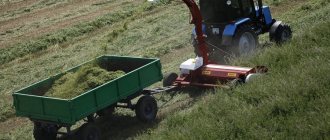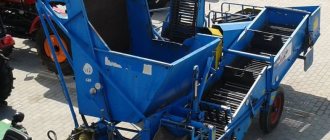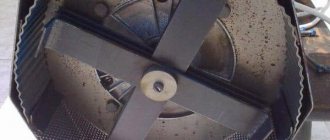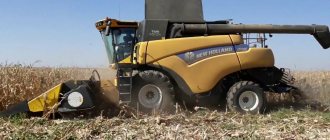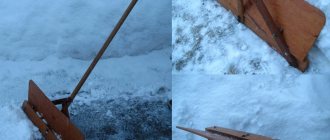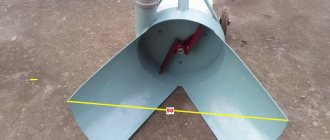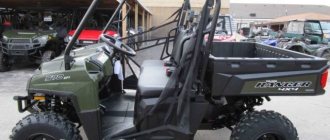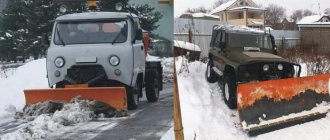About the device
As mentioned earlier, mini grain harvesters are practically no different from larger combines, performing absolutely identical work.
Such units collect the ears of corn and then grind them. It often happens that it is not necessary to immediately process what has been collected. In such cases, a grain hammer crusher is used. The final process will be to clean the resulting grain from straw and other debris.
The use of this technology allows you to simultaneously perform several tasks that were previously available only to a certain type of equipment performing each type of activity.
We are talking about a thresher, a winnower and a reaper.
As for modern mini grain harvesters, they can be equipped with additional equipment that can significantly expand their functionality. In particular, with the help of such units it becomes possible, in addition to harvesting grain, to sow vegetable seeds, knit sheaves, etc.
Most models of mini combines are equipped with a seat for the operator, and some are smaller copies of large combines, i.e. their design includes a full-fledged operator cabin.
Movement is carried out using three forward gears (some models may have more gears) and one reverse gear.
There are several levers in the cockpit, each of which is responsible for a specific task.
In particular, there is a clutch lever, a gear shift lever, as well as control levers with which you can adjust the cutting height of the ears. This is a very useful feature, especially in areas with slopes and difficult terrain.
These grain harvesting units have a low-power diesel engine , which allows significant savings on fuel consumption.
This is very important for individuals who have a fairly small subsidiary farm, where large capacities are not required, but the issue of saving is always quite acute.
At the final stage, when straw and other debris are removed, the grain ends up in a special bag or tank (in larger models). As for the straw, it is discharged through a different channel, separate from the cleaned grain material.
Based on this, we can summarize the main advantages of this type of technology:
- Affordable price for a mini harvester, which is acceptable for most categories of citizens.
- Economical fuel consumption, which has a positive effect on the cost of the final product.
- The compact dimensions of the unit allow it to show good maneuverability, which is very useful in areas where there is difficult terrain.
- Ease of operation allows you not to obtain a special permit or appropriate certificate.
- Possibility of carrying out repairs directly on the job site, without transportation to a service center.
- Due to their small dimensions, these mini harvesters can be easily stored in relatively small spaces.
For more information about the operation of the mini-harvester, watch the video:
Self-production
In order to successfully produce this kind of equipment, you will need to decide on the desired model, as well as acquire its drawings. After this, it is enough to make sure that all the necessary materials and tools are available, which will allow you to immediately begin the assembly process.
Required tools and materials
The assembly of the product will be completed successfully if you make sure in advance that all the necessary materials and tools are available. The simplest combine harvester can be made from available elements, among which it is advisable to note:
- metal profile;
- fittings;
- steel rods;
- wheels from old vehicles;
- pipe;
- ball or roller bearings;
- gears and chain;
- fasteners.
During the assembly process, the master will need a standard set of tools, as well as an angle grinder, a welding machine, a powerful drill and measuring instruments. It is extremely important to carry out all fixed connections of the structure by welding, which will ensure its reliability and long service life.
In order to make the design more accurate, you can use a drilling machine instead of an electric drill.
Blueprints
The choice of a suitable device model that you plan to assemble is of great importance. It must correspond to the available materials, but the master, if desired, can make changes to its design, which will allow him to adapt the constructed product to solve specific problems.
Assembly order
The assembly of a homemade combine harvester takes place in several main stages, the first of which is the manufacture of the frame. It should be rectangular in shape, and its base is a steel profile. You will need to attach the snare drum to it, as well as a support for the drive shaft.
It is highly recommended that the frame be constructed to be heavy in weight to minimize vibration during operation. For further assembly, please adhere to the following instructions:
- Make a frame for a grain drum. To do this, you can use pieces of steel corners that will need to be welded to the rims. The latter can be taken from old domestic cars, for example, Moskvich or VAZ. In this case, the end parts of the elements are cut off and the rings are welded.
- Place reinforcement bars between the corners and attach them using a welding machine.
- Assemble the shaft using a strong metal pipe of the required size. Place it in 2 supports that are attached to the frame of the unit. In this case, the shaft must be equipped with a gear, which will be used for a chain drive.
- Equip the drum with an outer casing, which is best made using a 200 liter steel barrel. Its upper part must be dismantled, which will allow quick cleaning or repair work if necessary.
- Drill holes for discharging grain, connect the halves of the casing using several bolts.
- Install the drive shaft on the frame; if desired, mount the gearbox on the opposite side of the unit. Mount the chain, paying special attention to its correct tension, which will prevent it from slipping during operation.
- Cover the chain with a protective casing, which can be made of steel or other materials, which will extend its service life.
- Mount a steel grate under the drum, which will allow straw to be collected.
Such a device appears to be a homemade drum-type harvester. It can operate by connecting to the tractor's power take-off shaft or to the rear axle.
Types, technical characteristics and prices
For private owners
A mini grain harvester for a private owner can be called such if its design complies with
certain
parameters and conditions. In particular, the “mini” category includes those units whose header working width does not exceed three meters, unlike trailed grain harvesters.
In most cases, this indicator varies from one to two meters.
Accordingly, the simpler the design of the combine, the lower this indicator, i.e. such models may lack not only a cab, but also a seat for the operator. A header working width of two meters or more is found in mini-harvesters equipped with a seat and a full-fledged closed cabin.
How to make a mini grain harvester with your own hands - assembling a homemade device
In principle, a homemade mini grain harvester can be made on the basis of any tractor, for example, the T-40. U
These units have all the necessary components that are necessary for the full operation of the combine, i.e. sufficiently powerful engine, wheelbase, driver's seat, etc.
Due to the fact that grain harvesting is carried out in the summer, the tractor cabin can be removed for greater driver comfort.
The main essence of the modification is to add a header to the tractor structure. You can take KPKU-75, whose working width is approximately three meters, or use another one. The Internet is full of advertisements for the sale of such components, so there should be no problems finding them.
Required tools and materials
List of required materials:
- Cuttings of metal profiles and fittings.
- Steel rod for making straw separating fingers.
- Several old car rims.
- Pipe section.
- Ball or roller bearings of the appropriate size.
- Housings for installing bearings.
- Gears and chain.
- Fasteners.
To make a stationary homemade grain harvester you will need the following tools:
- Welding machine.
- Electric edger and grinder (“grinder”).
- Set of wrenches and sockets.
- Electric drill or drill press and metal drill bits.
- Measuring tool.
Features of the device and technical characteristics of the Zarya MZK-800 mini-harvester
On private farms you can find small-sized agricultural equipment - the Zarya mini-harvester. It is used for harvesting grain vegetation from small plots of land, up to 10 hectares. The model is structurally no different from its larger analogues; it has a similar device, but at the same time it is relatively light weight and smaller in size.
Operating a mini-harvesting machine is considered much more profitable for small farmers, because it is characterized by:
- economical fuel consumption;
- minimum pressure on the soil;
- high maneuverability in difficult areas;
- maximum performance;
- versatility;
- simple technical care and maintenance;
- affordable price.
Harvester equipment
A unit of this design does not require the installation of additional equipment, since it is able to effectively cope with the main task - harvesting grain on small plots of land. If desired, you can modify the model by installing a fan to clean the grain from small impurities. You can also equip the structure with a grain storage capacity, which will allow you to take significantly fewer breaks in work due to the bunker overfilling. The presence of a headlight on the device will allow harvesting even in the dark.
The device requires regular maintenance, since the drum periodically becomes clogged with straw, and therefore the operating efficiency is significantly reduced.
Device features and technical description
The modern Zarya combine is produced in China. The design of the model is based on domestic technologies and developments, therefore small-scale agricultural equipment has the Russian Zarya brand.
In Russia and the CIS countries, the TM Zarya MZK-800 mini grain harvester is widely used, the direct purpose of which is to process low- and medium-sized crops. When attaching special header adapters, it harvests not only wheat and rye, but rice, sunflower, and corn. The basic configuration combines the functions of stem trimming, milking and separation in one transport unit.
The location of the assembly units is as follows:
- in front there is a mechanism for cutting stem vegetation and harvesting;
- in the center there is a conveyor and a threshing device;
- on the side there is a discharge of finished grains.
Thanks to this design, the machine works effectively with small-sized trucks like GAZ-3302.
A cabin is not installed on the Zarya combine harvester. The steering, working parts and driver's seat are attached to the equipment. If desired, a flexible awning is mounted on top to protect the driver from rain, snow and sun.
The configuration of the Zarya MZK-800 combine depends on customer requirements and operating conditions. As standard, grain harvesting equipment is equipped with an engine with a thrust of 50-150 hp. With.
Power plant parameters:
- Type - diesel.
- Number of cylinders - 4.
- Working capacity - 3.8 l.
Main performance indicators of the MZK-800 model:
- highest speed – 20 km/h;
- threshing drum diameter - 500 mm;
- cutting height of industrial crops - 50-800 mm;
- processing width - 2350 mm;
- fuel consumption - 0.4 l/h;
- productivity - 600 m²/h;
- overall dimensions - 8500x2900x3300 mm;
- vehicle weight - 4600 kg;
- operating temperature - up to +55°C.
The following are used as auxiliary equipment:
- diode lighting devices;
- receiving and assembly bunker;
- soil loosening agent;
- a soft roof or awning with risers and an auger for unloading.
Motor control is carried out by a mechanical 4-level (3 forward and 1 reverse) gearbox with hard gear shifting, clutch release is manual. The power unit is powered by a hydraulic pump, the front mechanism is powered by 3 hydraulic cylinders. The suspension is located on frame cushions.
Price and analogues
The Zarya combine is sold through existing factory representatives or private owners in Russia. The cost of equipment depends on the installation of the complete set, the location of the dealership center and the delivery method. The price of a new car is 150-350 thousand rubles. The standard purchase kit includes additional knives and consumables.
Among the harvesting analogues, German Claas, Chinese DongFeng and American John Deere are distinguished. Due to the installation of a luxury cabin, mini harvesters are much more expensive.
Review of mini combine harvester models
The production of such models is carried out not only by foreign, but also by some domestic manufacturers. When choosing a mini grain harvester, it is important to carefully study its characteristics, as well as the ability to connect additional attachments.
It’s worth mentioning the Zarya MZK-800 mini-harvester. This model is produced and is one of the best for cultivating fields with an area of no more than 6 hectares . This is due to the fact that, due to its light weight, it does not sink into the ground, as a result of which rutting does not occur when passing through wet or loose soil. The unit has low fuel consumption and increased maneuverability. Thanks to the ability to connect attachments, a mini-harvester can even be used to make a machine for harvesting various types of crops such as barley, corn, and sunflower.
Features of operating mini-reapers
Even taking into account that such models are small in size, they do an excellent job of cultivating fields with subsequent separation of ears and threshing them. As a result, such units are capable of simultaneously replacing 3 different devices. When installing trailed equipment, they will also knit sheaves of hay. Most models are equipped with classic gearboxes that have 3 gears intended for forward movement, as well as 1 for reverse. They are switched by a special lever. It is also possible to adjust the height at which the ears are cut.
Advantages of mini-harvesters
Based on all of the above, the following advantages of this technique can be identified:
- Ease of transportation of the unit.
- Low cost models.
- Possibility of use for small areas or in the presence of complex terrain, which is ensured by its small size and high maneuverability.
- Low fuel consumption.
- Easy to use mini-harvester.
- There are no complex components, which allows you to carry out repair work while in the field.
Manufacturing process
To make a stationary type machine, you need:
- Make a rectangular support frame from a steel profile to which the working drum and drive shaft support will be attached. The frame must be heavy to reduce vibration during operation. The supports can be equipped with screw adjusters, which will allow you to install the equipment on an uneven ground surface.
- Make the frame of a grain drum using pieces of steel angle, which is welded to 2 wheel rims from a VAZ or AZLK car. The end parts of the wheels are cut off, the rings are welded along the edges of the drum, ensuring structural rigidity.
- Reinforcement rods are welded between the corners, which help reduce the weight of the rotating assembly. All longitudinal elements have pieces of metal rod attached, which are used to pick up straw. The elements are placed at a slight angle, ensuring the ejection of waste material from the drum body.
- Make a shaft from a pipe of suitable diameter, which is mounted in 2 bearing supports located on the frame. On one side, the shaft is equipped with a gear designed to install a chain drive. It is possible to install gears on 2 sides, which provides equipment drive from various equipment.
- The outer casing of the drum is made of a steel drum with a capacity of 200 liters, the upper section tilts to the side, providing access to the mechanism for repairs and destraw. There are holes on the bottom of the body through which grain pours out. To connect the halves during operation, 2-3 bolts are used. It is possible to make a casing of other sizes or configurations yourself from sheet steel.
- A drive shaft with a gear is mounted on the frame. To provide drive from a vehicle, it is possible to install a gearbox on the other side of the combine. The installed chain must be tightly tensioned to avoid jumping. During installation, it is necessary to ensure the alignment of the drive and driven gears, as well as to eliminate axial runout of the elements. It is recommended to cover the chain with a protective cover to prevent contamination and excessive wear on the drive.
- A steel grate is installed under the drum in the housing, which ensures straw collection.
A homemade product of this design is a simplified combine harvester with an axial rotary drum.
A homemade combine harvester is connected to the power take-off shaft of a tractor or to the rear axle of a passenger car.
The supply of pre-cut stems is carried out through a hole made in the upper part of the casing. A guide tray made of multi-layer plywood is installed in front of the entrance.
The threshed grain and part of the fine straw are poured onto the ground or into a pre-prepared container. To remove small impurities, it is possible to use a fan with a guide channel. The device is driven by an additional gear included in the kinematic chain. Another disadvantage of the design is that the drum gets clogged with wet straw, which has to be cleaned out manually. The disadvantages include a high percentage of grain losses during threshing.
Is it worth making a mini-harvester with your own hands?
Due to the fact that most manufacturers do not immediately indicate the final price, they make it possible to select the desired functions of the model by pre-order. Due to this, it is possible to obtain equipment that will best meet the customer’s requirements. The minimum price tag for it starts from 100 thousand rubles. But to make a mini-harvester with your own hands, you will need to spend a significant amount of time and the availability of the necessary components. But in the end, the design may be significantly worse in quality, but it will be more expensive.
Modern mini grain harvesters are small equipment designed to cultivate fields with an area of up to 6-7 hectares.
Thanks to the ability in many models to connect additional attachments to them, their range of use is expanding. This makes them maneuverable multifunctional devices capable of working in small or complex areas.
The principle of operation of the combine
When planning to make a homemade mini combine harvester for harvesting grain with your own hands, you need to become more familiar with such devices, as well as the principle of their operation. Grain harvesters are universal units that are widely used in the agricultural sector to harvest various crops.
Most often they are used for harvesting wheat, rye, barley, and if additional equipment is installed, they can be used for harvesting corn, sunflower, buckwheat and many other varieties. To process large areas, self-propelled harvesters are used, which require the necessary qualifications and impressive financial costs.
Owners of medium and small plots of land most often use special tractor attachments, which are less efficient, but are easy to manufacture. The operating principle of classic combines involves performing the following list of actions:
- cutting ears;
- their transportation to the thresher;
- threshing of collected raw materials;
- cleaning the heap;
- transportation of cleaned grain to a bunker for subsequent unloading at the storage location.
Mini-devices, including homemade ones, are capable of performing all of the above operations, however, compared to traditional models, they are compact in size.
Device
If you want to assemble a grain harvester with your own hands, you must take into account that the design of the product may differ and depends on its type. There are self-propelled, trailed, and mounted mechanisms, which allows everyone to choose the best option. Also worthy of mention are the simplest models, which are controlled using handles and levers.
If properly manufactured, the unit will not be inferior in quality to its factory counterparts, since its use will save up to 99% of the collected raw materials. The key design elements of such a device are:
- a bunker used to receive raw materials;
- chamber in which threshing is carried out;
- conveyor, with the help of which raw materials are supplied to the required sections of the mechanism;
- a special device that allows you to separate grains from straw.
It is necessary to mention a fan, which may be included in the design of some models. It is necessary for cleaning grain from dust and dirt, but simple homemade products can work without it. If it is not provided, the grain will need to be separated from the mass independently, after successful collection.
Mini tractor based on a walk-behind tractor with an AM-4 adapter (8.5 hp, 6×12 wheels, differential)
The walk-behind tractor is equipped with a six-wheel gearbox on differentials and with a headlight!
Modern walk-behind tractor Shtenli
1030 is designed to perform a wide range of work: harrowing, inter-row cultivation, soil plowing. The walk-behind tractor belongs to a new generation of agricultural machinery and can be used by both professionals and amateurs.
Four-stroke engine with 8.5 horsepower, makes Shtenli
even more reliable. The special shield of the working cutters guarantees the operator’s protection during the cultivation process from dirt, lumps of soil and stones.
The universal walk-behind tractor is very economical, as it consumes little gasoline. The spacious fuel tank allows you to work continuously without being distracted by refueling.
Powerful pneumatic wheels measuring 6.0x12 increase the stability of the cultivator. High tire tread allows the use of a reliable Shtenli
1030 as a tractor. The balance of the handle and the weight of the drive creates comfortable conditions for the driver during operation. The ability to adjust “for the operator” adds convenience in cultivating the land. If necessary, the handles can be moved to the side. This way you will walk on the side of the cultivator and not trample previously cultivated soil.
